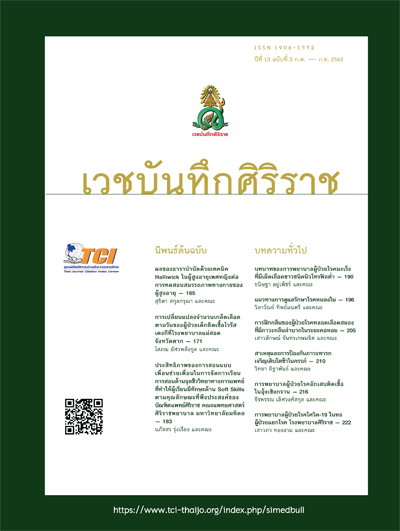การฝึกกลืนผู้ป่วยโรคหลอดเลือดสมองที่มีภาวะกลืนลำบากในระยะคอหอย
Main Article Content
Abstract
Dysphagia is a major complication of stroke. Pharyngeal dysphagia after a stroke is a common and serious problem that can lead to pneumonia and poor quality of life. Knowing the cause can be a helpful method for rehabilitation program of swallowing problem. Evaluation of the dysphagia should be considered regarding, personal history, medical history swallowing potency and water test. Training in pharyngeal stage may involve swallowing exercise, the use of Neuromuscular Electrical Stimulation improve movement and strengthen swallowing muscles along with other techniques to promote this process. Appropriate dysphagia rehabilitation significant decrease the risk of aspiration pneumonia and death.
Article Details
How to Cite
1.
จันทรเกษมจิต เ, เลาหสินณรงค์ ไ, ดวงตระกูล อ. การฝึกกลืนผู้ป่วยโรคหลอดเลือดสมองที่มีภาวะกลืนลำบากในระยะคอหอย. เวชบันทึกศิริราช [internet]. 2020 Jul. 2 [cited 2025 Dec. 25];13(3):205-9. available from: https://he02.tci-thaijo.org/index.php/simedbull/article/view/217182
Section
Review Article
References
1. Enderby P, Pickstone C, John A, Fryer K, Cantrell A, Papaioannou D. Resource manual for commissioning and planning services for speech, language and communication needs. London, England: Royal College of Speech and Language Therapists. 2009.
2. Geeganage C, Beavan J, Ellender S, Bath PMW. Interventions for dysphagia and nutritional support in acute and subacute stroke. Cochrane Database of Systematic Review 2012; 10
3. โชคชัย เมธีไตรรัตน์, เนตรา บัวกนก, ภาวิน เกตุกุล, วรุตม์ พงศาพิชญ์, สุนันท์ องอาจ. Management for Dysphagia Patients. เวชศาสตร์ทันยุค 2553: 535-42
4. American Occupational Tharapy Association. AOTA specialty certification for occupational therapy. American Journal of Occupational Tharapy 2006; 59: 663-665
5. Avery W. Dysphagia. In: Randomski MV, & Latham CAT, editors. Occupational therapy for Physical Dysfunction. 6th ed. Baltimore: Lippincott Williams & Wilkins; 2008. P. 1322-44
6. Maccarini AR, Filippini A, Padovani D, Limarzi M, Loffredo M, Casolino D. Clinical non-instrumental evaluation of dysphagia. Acta Otorhinolaryngol Ital. 2007 Dec;27(6):299-305.
7. Logemann JA. Treatment of oral and pharyngeal dysphagia. Physical medicine and rehabilitation clinics of North America. 2008 Nov 1;19(4):803-16.
8. Sze WP, Yoon WL, Escoffier N, Liow SJ. Evaluating the training effects of two swallowing rehabilitation therapies using surface electromyography—Chin tuck against resistance (CTAR) exercise and the Shaker exercise. Dysphagia. 2016 Apr 1;31(2):195-205.
9. ภัทรา วัฒนพันธุ์. ภาวะกล้ามเนื้อหูรูดหลอดอาหารส่วนบนผิดปกติ. เวชศาสตร์ฟื้นฟูสาร. 2557; 24(3): 73-75
10. Wada S, Tohara H, Iida T, Inoue M, Sato M, Ueda K. Jaw-opening exercise for insufficient opening of upper esophageal sphincter. Archives of physical medicine and rehabilitation. 2012 Nov 1;93(11):1995-9.
11. Oh DH, Won JH, Kim YA, Kim WJ. Effects of jaw opening exercise on aspiration in stroke patients with dysphagia: a pilot study. Journal of physical therapy science. 2017;29(10):1817-8.
12. Daniels S. Unilateral Vocal Cord Paralysis and Dysphagia[Internet]. 2004 [cited 2018 Jul 5]. Available from: https://www.speechpathology.com/ask-the-experts/unilateral-vocal-cord-paralysis-and-1132
13. Byeon H. Effect of the Masako maneuver and neuromuscular electrical stimulation on the improvement of swallowing function in patients with dysphagia caused by stroke. Journal of physical therapy science. 2016;28(7):2069-71.
14. ภัทรา วัฒนพันธุ์. คู่มือการฟื้นฟูสภาพสำหรับผู้ป่วยสำหรับผู้ป่วยที่มีภาวะกลืนลำบาก. พิมพ์ครั้งที่ 2 .กลุ่มวิจัยภาวะกลืนลำบาก คณะแพทยศาสตร์ มหาวิทยาลัยขอนแก่น; 2560
2. Geeganage C, Beavan J, Ellender S, Bath PMW. Interventions for dysphagia and nutritional support in acute and subacute stroke. Cochrane Database of Systematic Review 2012; 10
3. โชคชัย เมธีไตรรัตน์, เนตรา บัวกนก, ภาวิน เกตุกุล, วรุตม์ พงศาพิชญ์, สุนันท์ องอาจ. Management for Dysphagia Patients. เวชศาสตร์ทันยุค 2553: 535-42
4. American Occupational Tharapy Association. AOTA specialty certification for occupational therapy. American Journal of Occupational Tharapy 2006; 59: 663-665
5. Avery W. Dysphagia. In: Randomski MV, & Latham CAT, editors. Occupational therapy for Physical Dysfunction. 6th ed. Baltimore: Lippincott Williams & Wilkins; 2008. P. 1322-44
6. Maccarini AR, Filippini A, Padovani D, Limarzi M, Loffredo M, Casolino D. Clinical non-instrumental evaluation of dysphagia. Acta Otorhinolaryngol Ital. 2007 Dec;27(6):299-305.
7. Logemann JA. Treatment of oral and pharyngeal dysphagia. Physical medicine and rehabilitation clinics of North America. 2008 Nov 1;19(4):803-16.
8. Sze WP, Yoon WL, Escoffier N, Liow SJ. Evaluating the training effects of two swallowing rehabilitation therapies using surface electromyography—Chin tuck against resistance (CTAR) exercise and the Shaker exercise. Dysphagia. 2016 Apr 1;31(2):195-205.
9. ภัทรา วัฒนพันธุ์. ภาวะกล้ามเนื้อหูรูดหลอดอาหารส่วนบนผิดปกติ. เวชศาสตร์ฟื้นฟูสาร. 2557; 24(3): 73-75
10. Wada S, Tohara H, Iida T, Inoue M, Sato M, Ueda K. Jaw-opening exercise for insufficient opening of upper esophageal sphincter. Archives of physical medicine and rehabilitation. 2012 Nov 1;93(11):1995-9.
11. Oh DH, Won JH, Kim YA, Kim WJ. Effects of jaw opening exercise on aspiration in stroke patients with dysphagia: a pilot study. Journal of physical therapy science. 2017;29(10):1817-8.
12. Daniels S. Unilateral Vocal Cord Paralysis and Dysphagia[Internet]. 2004 [cited 2018 Jul 5]. Available from: https://www.speechpathology.com/ask-the-experts/unilateral-vocal-cord-paralysis-and-1132
13. Byeon H. Effect of the Masako maneuver and neuromuscular electrical stimulation on the improvement of swallowing function in patients with dysphagia caused by stroke. Journal of physical therapy science. 2016;28(7):2069-71.
14. ภัทรา วัฒนพันธุ์. คู่มือการฟื้นฟูสภาพสำหรับผู้ป่วยสำหรับผู้ป่วยที่มีภาวะกลืนลำบาก. พิมพ์ครั้งที่ 2 .กลุ่มวิจัยภาวะกลืนลำบาก คณะแพทยศาสตร์ มหาวิทยาลัยขอนแก่น; 2560


